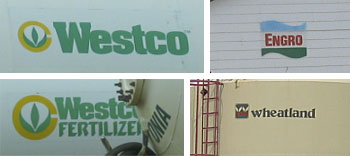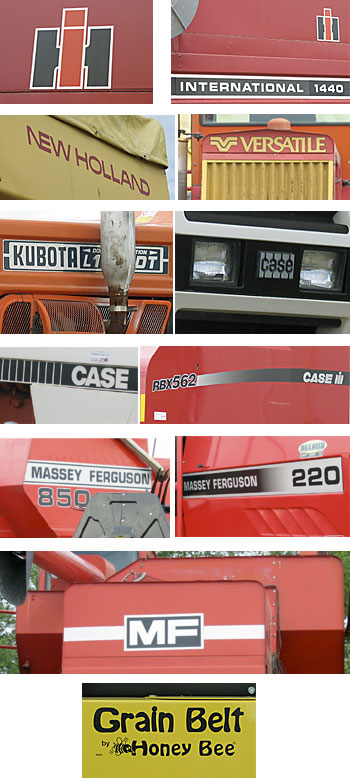I’ve just returned from a road trip to Saskatchewan—that’s the prairies, land of the small town and almost non-existent village. City verticality disappears as the land stretches out before you; even the towns display a horizontal front with their wide streets and one- and two-story buildings.
With this change in the landscape I also noticed a change in the graphic visual scape. In villages of 20 to 3,000 people the towering presence of corporations familiar to us as city-dwellers all but disappears. Gone are the McDonald’s, Safeway, Home Depot, Nike and Wall-Mart. In their place, the independent restaurant, grocery and hardware store reigns, with the usual jumble of eclectic, quirky signage. The faded, hand-painted sign of Hazel’s Coffee Shop (its letters crazily misaligned where “Hazel’s” is painted over the trace outline of “Bob’s”, begging all sorts of questions about the history of said cafe) competes, competently enough, with the Helvetica all-caps of Shanghai Family Restaurant—Canadian and Chinese Cuisine, across the dirt street.

My favourite sign, perhaps, was painted in large, black sans caps on the front and side of a white clapboard building in a village that appeared to have a population of 10 at the most. It said, “Throne Store,” effectively telling me that this place was called Throne, and here was its store. Short and to the point.
Now I do apologize for not having more pictures. Snapping photos of signage as you zoom by at … ahem … excessive speeds is not easy. Nor is slamming on the brakes, or—if one is not driving—convincing one’s driving partner to stop and turn around. But I did get enough to illustrate some points I think.
The prairie grain elevator, for those who don’t know, was once the ubiquitous landmark of every town. It served as both signage for the town and as billboard for the grain company to which it belonged.

These used to be Pioneer, UGG (United Grain Growers), Pool (Wheat Pool), and Cargill. Unfortunately, most grain collection has become centralized and this signage, along wth the iconic grain elevators themselves are rapidly disappearing.
Even the smallest of towns seem to be investing in some pretty fancy “Welcome” signage, perhaps since the demise of their practical announcement of presence on the grain elevator. There is a common theme: the name of the town, often a slogan or message, some icons that depict the region, and lots of colour.

Of special note is the Co-op. A behemoth on the prairies, but unknown everywhere else, this purveyor of groceries, hardware and gasoline is present in towns and cities of every size across Alberta, Saskatchewan and, I presume, Manitoba. Following is a rare occurrence of their old 2-colour logo. These days it is represented only in red on white or white on red as you can sortof see on the flag.

I began to think about the locals of these small towns, and in particular the farmers, from the perspective of what they see and are familiar with on a day-to-day basis. Corporate logos are not absent here, they are merely different from what I’m used to. As I began looking at the landscape with an eye for graphics, I started to become obsessed.
Metal grain bins marked with the logos of Twister, Butler, Flaman, Steel-Rosco, and Westeel.

Buildings, bins, tanks and towers sported the logos of what I presume are fertilizers, herbicides, pesticides and other chemicals.

Trains have a much higher presence here.

Vehicles are mostly GM, Ford and Chrysler products (and what a relief it is to see all those trucks driven by people who actually need trucks!). Gone are the Mercedes, BMW, Lexus and VWs that populate Vancouver. Even my Subaru draws a stare—”not from around here,” they know even before checking my out-of-province plates. (Here’s fun: drive into a really small town on the prairies, drive slowly up and down the residential street(s), and then leave. The locals will gawp.)
And then there’s the farm machinery. Case, International Harvester, Massey Ferguson, New Holland, Kubota …

and that country sweetheart of design (god knows why), John Deere.

I went up to the lakes region and started to notice the logos of campers and motor homes, spanning 30 years. Travelaire, Scamper, Prowler, Vanguard, Slumber-Queen, Frontier, Shasta, …
Alas, my desperate photos taken through the bug-smeared windshield did not exactly turn out.
Oh, and we too have an election year, though ours is mercifully over while yours in the US drags on. Most campaign signage is of the mass-produced, predictable variety, but I did see a couple of the following for the man who campaigns with neither a last name nor a political party, which I found to be one of the most highly visible home-made signs I’ve ever seen.

I have provided no critical commentary on this adventure in an alternate logoscape (this is, after all, not a book), but it was interesting to look at my world (graphics) from a different perspective and it’s something I hope to remember to practice again, the next time I enter a landscape not my own.









You city folk and yur fancy pants e-lectronic picture machines.
I live in Hartville, Ohio, home to the Menonites (Amish people with cars) and their monstrous structures. The hub of town is the local Giant Eagle — once an IGA — that competes with a small-time grocery chain and civilization dwindles as you travel in any direction.
After a lifetime of living in a small town, you develop a love-hate relationship with the 'design' of your environment. So many signs lend themselves to the Podunk atmosphere, yet it's hard to look at one and not think, "Boy, I could really make something of that place."
Think of it like being surrounded by potential work, with no real means of tapping into the source. Of course, this doesn't mean that I'd like to pave the farmland; however, the llama farms shouldn't be allowed to have the best signage in town. It just isn't right.
On Jul.08.2004 at 02:04 AM